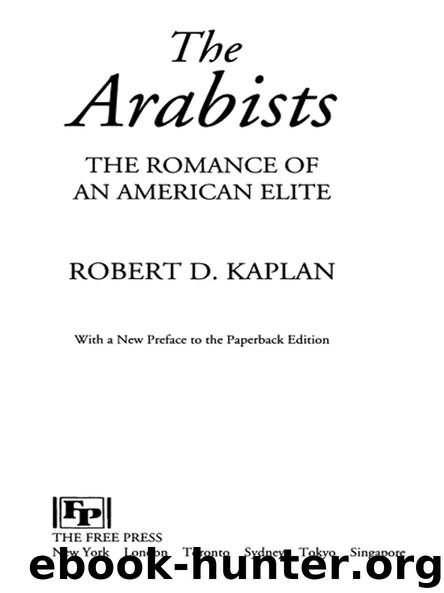Arabists: The Romance of an American Elite by Robert D. Kaplan

Author:Robert D. Kaplan [Kaplan, Robert D.]
Language: eng
Format: epub, mobi, azw3
Publisher: Free Press
Published: 1995-06-30T22:00:00+00:00
In a word, Kissinger thought of FSOs as a bunch of missionaries, out to do good and to meet villains halfway, at the expense of the national interest.
Kissinger’s brilliance of manipulating the bureaucracy was demonstrated by his decision to keep Sisco as NEA assistant secretary. Sisco was generally seen to be Rogers’s man, and Kissinger was known to dislike Rogers. Moreover, Kissinger took a dim view of Sisco’s constant attempts at peacemaking, which Kissinger derided as “activity for activity’s sake.” Obviously, however, Kissinger correctly divined how powerful a tool Sisco would be as “his” man. Although Joe Sisco, like Hermann Eilts, never thought twice about talking back to Kissinger—screaming at him, even—Kissinger tolerated dissent from people he deeply respected.
Mike Sterner is one old hand who takes a reflective view of the change Kissinger and Sisco wrought at the State Department, and particularly at NEA: “Kissinger brought a healthy corrective to foreign policy. He saw how decision making suffered from uncontrolled bilateralism. It’s true, there is a built-in institutional bias in favor of bilateral relations at the State Department [relations between the United States and this Arab country, between the United States and that Arab country, etc.]. So Kissinger introduced a new architecture, whereby institutional checks were put in place to keep matters in perspective, because certain states and ideals were always more important than others.”
The 1973 Yom Kippur War, though a partial result of Nixon and Kissinger’s neglect of the Middle East after their victory in the 1970 Jordan crisis, provided Kissinger with the perfect opportunity to quickly disprove the classic Arabist notion, most clearly articulated by Loy Henderson, that the United States had to choose friendship with twenty-odd Arab states or with one Jewish state, because it couldn’t have both.
Well, yes, it could. Though Israel won the war, it had been badly bloodied by Sadat’s surprise attack across the Suez Canal, and Syrian leader Hafez Assad’s attack on the Golan Heights. Israel’s strategic and psychological advantage over its Arab neighbors had been drastically reduced. This setback allowed Kissinger to pressure Israel into concessions. The Arab states now learned that only the United States precisely on account of its close relationship with Israel, could get back their lost territory. So even as the U.S.-Israeli relations remained close, Syria and Egypt renewed official ties with Washington.
Kissinger, Sisco, and Atherton were the core of the State Department’s traveling team for the historic negotiations that followed the October 1973 war, negotiations that involved the reopening of the Suez Canal, the withdrawal of Israeli forces from the western part of Sinai, and the creation of a demilitarized zone in the Golan Heights. Hermann Eilts was the man they chose to reopen the U.S. embassy in Cairo, and Richard Murphy was their man to reopen the U.S. embassy in Damascus.
It was Atherton who had spotted Dick Murphy as sort of “a new breed, nonbaggage, non-Arabist Arabist.” But what distinguished Murphy from old hands like Seelye, Parker, Stoltzfus, Killgore, Sterner, and others was much subtler: rather
Download
Arabists: The Romance of an American Elite by Robert D. Kaplan.mobi
Arabists: The Romance of an American Elite by Robert D. Kaplan.azw3
This site does not store any files on its server. We only index and link to content provided by other sites. Please contact the content providers to delete copyright contents if any and email us, we'll remove relevant links or contents immediately.
| Africa | Americas |
| Arctic & Antarctica | Asia |
| Australia & Oceania | Europe |
| Middle East | Russia |
| United States | World |
| Ancient Civilizations | Military |
| Historical Study & Educational Resources |
Cat's cradle by Kurt Vonnegut(14763)
Pimp by Iceberg Slim(13781)
Underground: A Human History of the Worlds Beneath Our Feet by Will Hunt(11840)
4 3 2 1: A Novel by Paul Auster(11794)
The Radium Girls by Kate Moore(11624)
Wiseguy by Nicholas Pileggi(5320)
American History Stories, Volume III (Yesterday's Classics) by Pratt Mara L(5138)
Perfect Rhythm by Jae(5074)
The Fire Next Time by James Baldwin(5021)
Paper Towns by Green John(4803)
Pale Blue Dot by Carl Sagan(4620)
A Higher Loyalty: Truth, Lies, and Leadership by James Comey(4554)
The Mayflower and the Pilgrims' New World by Nathaniel Philbrick(4283)
The Doomsday Machine by Daniel Ellsberg(4248)
Killers of the Flower Moon: The Osage Murders and the Birth of the FBI by David Grann(4191)
Too Much and Not the Mood by Durga Chew-Bose(4096)
The Sympathizer by Viet Thanh Nguyen(4096)
The Borden Murders by Sarah Miller(4021)
Sticky Fingers by Joe Hagan(3913)
